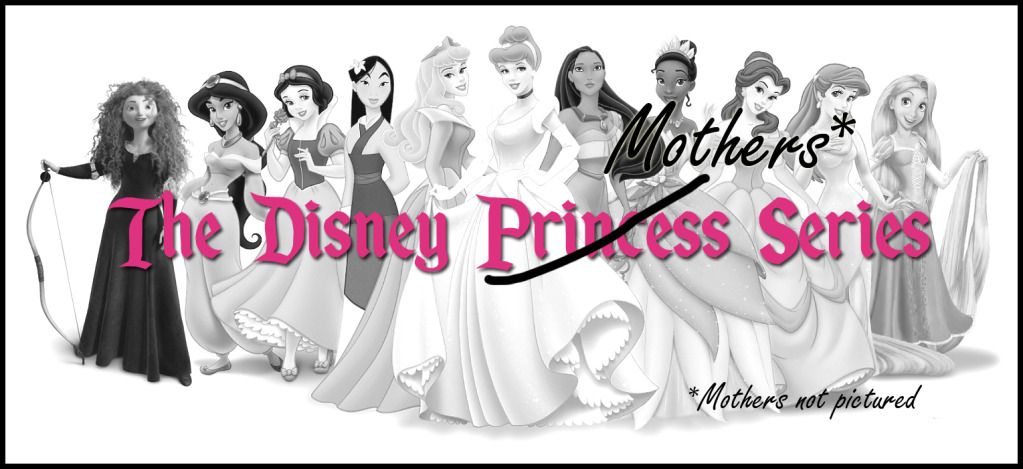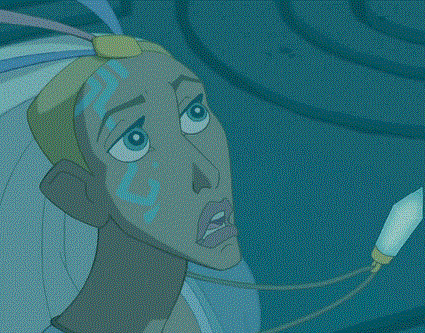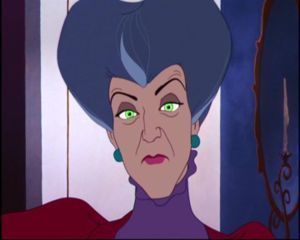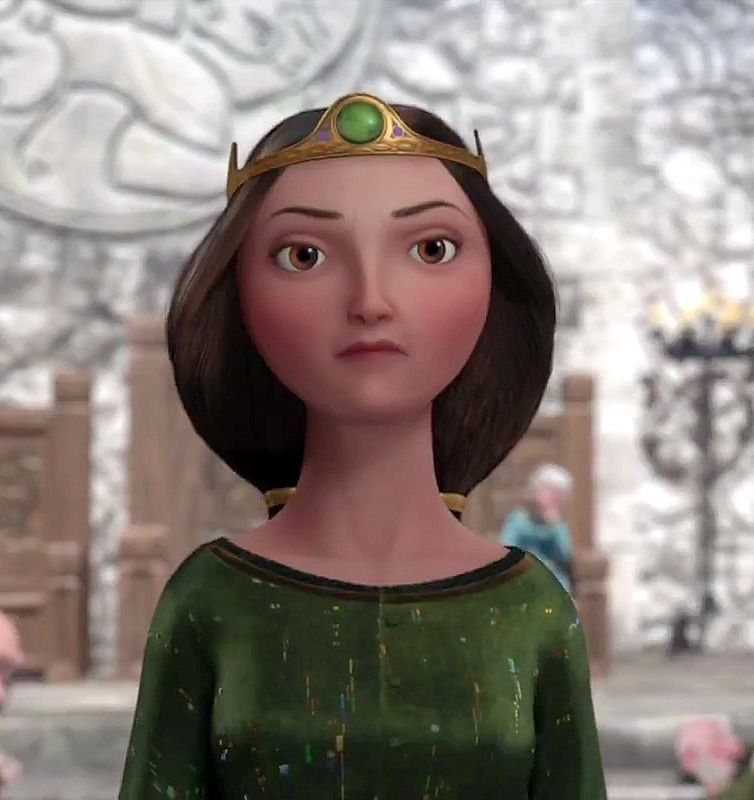Disney has a problem with mothers. This is incontrovertible fact. However, just as the Disney princesses have developed over the decades, so too have their mothers; some of them are even still alive during the events of the film!
In this post we have limited ourselves to discussing only those mothers and mother figures whose daughters we have already mentioned. We will also only be dealing with the original films. Sorry, The Little Mermaid: Ariel’s Beginning, a sequel we didn’t even know existed before writing the princess series.
In all seriousness, there is a lot to say about Disney mothers, especially those who could easily be credited as Lady Not-Appearing-in-This-Film. The princesses have historically been defined by their relationships to their fathers and to their male love interests, and when women play a major role in their development, it is almost invariably as an antagonist. Still, we find ourselves fascinated by the women who have a hand in shaping these characters.
The M.I.L.L.s
The above acronym stands for Mothers I’d Like to Live, the group of mothers who died before the story begins and whose presence is hardly even missed in the narrative. It particularly describes the mothers of Ariel, Belle, and Jasmine, although Jasmine’s mother is given one mention; the Sultan complains about Jasmine’s reluctance to get married, stating, “I don’t know where she gets it from. Her mother wasn’t nearly so picky.” The maternal absence in each of these films is fascinating, especially in light of the important roles played by each woman’s father.
It is also interesting in light of the tremendous female presence in the first three Disney princess films. Whereas all three of these princesses have some sort of maternal figure, wicked or otherwise, the revival characters seem to be produced primarily by men, almost as if through asexual reproduction. This is partially the fault of the source material; “Beauty and the Beast” has always been about the protagonist’s father doing something foolish, and the Sea King is a widower in Hans Christian Andersen’s story. We can’t help but wonder if there’s more to the lack of mothers, though. Perhaps Disney was reluctant to go the wicked stepmother route in their portrayals of independent, adventurous females, as if antagonistic maternal figures would make the story too domestic for characters looking for adventure in the great, wide somewhere. Perhaps in removing the maternal figure altogether, Disney was trying to make the revival princesses seem more self-reliant -- these are women who don’t need their mommies. Perhaps they wanted a completely different kind of princess to mark their rebirth. Perhaps, and this is probably the most depressing and most likely option, they just didn’t notice.
The Living Dead
Disney has featured so many characters with dead mothers that we can split them into two categories. This one includes all those mothers who, despite dying, have managed to remain relevant to the plot.
Pocahontas’ mother is the first to achieve this distinction. Before we see Pocahontas for the first time, we learn that she is very much her mother’s daughter. She has her mother’s spirit and “goes wherever the wind takes her.” It is her mother’s necklace that Powhatan gives to Pocahontas, telling her that her mother had wanted Pocahontas to wear her mother’s necklace at her own wedding. Pocahontas wears it for the rest of the film. It also suggested on several occasions that her mother has become a kind of wind spirit; considering the integral role the wind plays in most of the key scenes (John Smith and Pocahontas’ first meeting, “Colours of the Wind,” and Pocahontas’ race to save John Smith), it would be fair to say that her mother orchestrates much of the story. She also plays matchmaker for her daughter and, were it not in the service of securing peace, it might be a little creepy. However, what is perhaps most interesting about her mother’s influence is the way in which it allows the film to subvert the usual tropes of the princess series: Pocahontas essentially gives up on true love in order to remain with her people. Powhatan had earlier observed that the people looked up to her mother for wisdom and strength, and Pocahontas clearly takes on her mother’s legacy, just as she took on her necklace.
The other mother in this category is the queen of Atlantis. Unlike Pocahontas’ mother, she has a corporeal presence in the world of the film. We meet her at the same time as we meet Kida: as Atlantis begins its descent into the depths. Indeed, it is Kida’s mother who preserves the city, having been taken by the Heart of Atlantis to form a protective force field around the city. Kida, traumatized after having her mother literally pried from her fingers, becomes obsessed with their history and culture in order to find an explanation for her mother’s disappearance. When she follows in her mother’s footsteps and is also chosen to be absorbed by the Heart of Atlantis, it appears as if Kida has at last managed to make some contact with her mother. She returns with the bracelet her mother had slipped from her wrist as she ascended to the Heart.
Both of these characters are represented by objects, as if to provide them with some solid, if indirect, presence in the world of the film. The fact that these objects are worn by their daughters suggests that they have a hand in their daughters’ accomplishments.
The Just There Moms
This group includes the mothers of Mulan, Aurora, Rapunzel, and Tiana. Mulan’s story revolves her taking her father’s place in order to earn his respect, so it is not surprise that her mother plays a secondary role. She doesn’t even get to provide some comic relief, as that role is already filled by Mulan’s grandmother. Fa Li basically gives Mulan a makeover and helps her husband deliver the exposition that Mulan will be killed if they reveal that she is a woman. However, she is the first mother of a “princess” to be alive in the film since Sleeping Beauty, which is an accomplishment in itself.
Aurora’s mother, whose name is apparently Leah, just exists. She gets a single line, and even gets passed over in the fairies’ line about the people waiting for Aurora at home.
Rapunzel’s mother, the nameless Queen, serves the plot in a very passive way. While pregnant with Rapunzel, she falls ill and must be healed by the flower that gives Rapunzel her powers. Other than that, she generally just looks sad. At the same time, she represents a subtle but interesting shift in perception. Whereas Aurora was returned first and foremost to King Stefan, Rapunzel is greeted first by her mother. It is her mother whose grief we follow more closely, and it is she who identifies the newly brunette daughter she lost.
Despite being voiced by Oprah, Eudora does not buy a restaurant for Tiana; instead, she serves as a kind of guide into the realm of fairy tales. She is the one who reads the story of the frog prince to Tiana and Charlotte while helping to cement Charlotte’s obsession with princesses by making her elaborate dresses. Later, when Tiana is an adult, she tries to relay her husband’s message that Tiana should focus on personal relationships as well as work; he didn’t get his restaurant, Eudora concedes, “but he had something better. He had love. And that’s all I want for you, sweetheart: to meet your Prince Charming and dance off into your happily-ever-after.” Needless to say, Eudora’s not our favourite Disney mom.
The Wicked Stepmothers
This is perhaps Disney’s favourite kind of mother. You can tell by the almost palpable glee the writers and animators took in depicting these truly awful human beings. Numbered among this group’s members are Snow White’s wicked stepmother (which is her actual description in the storybook opening), Lady Tremaine, and Mother Gothel.
The first of these ladies is the most overtly, single-mindedly evil of the lot. Obsessed with her own beauty, the Queen orders the huntsman to kill Snow White the moment she learns that she has been dethroned as the “fairest one of all.” When she learns that her rival is still alive, she decides that if you want something done right, you’ve got to disguise yourself as a hag, cook up a poisoned apple, travel through the woods, and do it yourself. Then she dies ugly, ‘cause payback’s a bitch.
Lady Tremaine seems slightly less evil, if only because you can see that the awful things she does are technically intended to benefit her own daughters. She is described in the voice-over as “cold, cruel, and bitterly jealous of Cinderella’s charm and beauty.” We’re more than a little troubled by the idea that the antagonistic relationships that Cinderella and Snow White have with their respective stepmothers stem explicitly from jealousy over their beauty. It is as if no more legitimate reason for their hatred needs to be provided, because physical attractiveness is all that matters. Still, you’ve got to hand it to Lady Tremaine; she knows how to crush a spirit. Using Cinderella’s own hope against her, she allows her stepdaughter to believe that she might attend the ball, only to destroy this dream at the moment Cinderella is certain it will come true. This is a wicked stepmother that I could see instructing her daughters to cut off bits of their feet so they can become queens.
Then there’s Mother Gothel, who, with a few precise verbal incisions, can remove her daughter’s entire self-esteem. For those who claim to see Stockholm Syndrome in Beauty and the Beast, turn your eyes to this doozy of a mother-daughter relationship and witness the real thing. Watching this film, we found it particularly irritating to see Rapunzel let down both her hair and herself from the tower, as it proved that she could have done it at any time. However, it is clear that Gothel’s eighteen-year annihilation of her self-confidence kept Rapunzel inside. Gothel’s methods are insidious because she disguises so many of her controlling messages with seemingly caring sentiments. She ends discussions with a show of her devotion (“I love you very much, dear.” “I love you more.” “I love you most.”) which only serves to make her behaviour that much more chilling because, in a way, she really does love Rapunzel. She makes her favourite foods, journeys for days in order to make her special paints, and likely teaches her at least some of the many activities she uses to occupy herself. However, we know that when she says, “I love you most,” she’s really talking to Rapunzel’s hair.
The Maternal Figures
This category exists purely so we can talk about the good fairies and Lilo’s sister, Nani, something that we do often, at length, in our real lives.
The good fairies take Aurora in as an infant and raise her as their own. They do this despite knowing nothing about child rearing or domestic upkeep. They also do this without the assistance of the wands on which they have evidently relied for their entire lives. Still, they know that they must protect her for the good of the kingdom, so they are willing to make a sacrifice that, despite being played as a joke, is actually quite impressive.
Although she is technically Lilo’s sister, their parents’ death forces Nani to become a kind of single mother at nineteen. She must work a low-paying job, prepare meals, and do the chores, all while taking care of the bizarre Lilo. And she can’t keep up, but the film never really blames her for that, because Nani tries so hard. When Lilo wants a friend, she agrees to get her a pet. When Lilo wants the ugly, blue, possibly undead dog, Nani lends her the money so Lilo can claim Stitch as her own. When said blue dog makes Nani lose her job and, potentially, Lilo, Nani works to find a new position literally anywhere. Although Lilo and Stitch both bring up the concept of “ohana,” it is Nani who embodies it. Her life would be infinitely easier if she didn’t have to take care of Lilo, but instead of giving herself freedom, she strives at every opportunity to keep her family together.
The Co-Protagonist
Here is where we come clean with another disclaimer: this entire post was initially planned just so we could talk about the greatest of Disney mothers, Elinor. Yes, we’re fangirls. No, we’re not sorry.
There’s no reason to apologize for fangirling a character as nuanced and fascinating as Elinor, queen of DunBroch. Although her husband was selected to be king, it is Elinor who both literally and figuratively wears the crown; his military prowess gained him the title, but her diplomacy secures it. She also orchestrates the search for the next king and, when the current one cannot remember the lines she obviously wrote for him, she runs the betrothal competition herself. She controls a room merely by walking through it, because she commands respect. In her voice-over, Merida complains, “I'm the princess. I'm the example. I’ve got duties, responsibilities, expectations. My whole life is planned out, until the day I become, well, my mother. She's in charge of every single day of my life.” To cap off this same scene, Elinor sums up the duty of a female sovereign-in-training: “above all, a princess strives for...well, perfection!” It is obvious that Elinor holds herself to the same standard, and the gray streak in her hair is a visual reminder of the toll her need to maintain perfection takes.
The central object in the film, the tapestry depicting the family DunBroch, is proof of this obsession with perfection. Faced with the reality of her boisterous husband, her mischievous sons, and her rebellious daughter, Elinor instead portrays them as a flawless, static family, even going so far as to tame Merida’s wild curls. When Merida slices through the false Elinor and Merida’s handhold, she not only ruins the tapestry, but destroys the image of the perfect family that Elinor needs to project.
There are also more profound implications for Merida’s rash act. Elinor is portrayed as the keeper of tradition and history, using this history in its narrative form as legend to impart knowledge of the kingdom’s past to the next ruler. Telling Merida the story of the fourth brother and the kingdom he caused to topple, she observes that “legends are lessons and they ring with truths.” In telling these stories, Elinor demonstrates that she is not just a maker of laws but a maker of meaning. Her work, then, carries great weight. The tapestry is an ideal image, but it is also an artifact depicting the first monarchs of a new kingdom. Merida physically destroys historical evidence of their reign and, in slicing through the handhold, symbolically severs the link between one ruler and the next.
And then we come to the more literal implications of this destructive act; by cutting through the handhold, Merida makes evident the rift between mother and daughter that forms the crux of this film. When we first meet Elinor, she is playing with Merida, pretending to be a monster that will gobble her child up. It’s a situation rarely seen in films: a mother just having fun with her daughter. Later, in a flashback, we see the seemingly stoic Elinor’s devotion to Merida, as she promises her daughter that she will always be there for her. But there is a difference between being physically present and being supportive. By the time Merida is a teenager, Elinor’s actions are primarily motivated by her concern for the good of the kingdom. As Merida tries to tell her mother about her climb up to the Fire Falls, Elinor reads the acceptance letters from the three lords; while Merida practically begs Elinor to acknowledge her as a person, Elinor is planning her fate as a political tool. As a badass queen trying to train a ruler of equal or greater badassery, she forgets that said heir is her daughter.
And it comes back to bite her. As we observed in our discussion of Merida, one of the things we really love about this film is the fact that everything is driven by women’s agency, and the main focus of the plot – Elinor being turned into a bear – is no exception. It is the result of both women’s actions, as Merida slices through the tapestry and Elinor responds by throwing Merida’s bow – the symbol of her freedom and identity – into the fire. The difference is that Elinor immediately regrets her actions, while Merida decides to order a spell that will change her fate by circumventing her mother’s own agency.
So much of femininity – and, accordingly, so much of this film – is about performance, and transforming the image-conscious Elinor into a bear is like giving her a script entirely written in Klingon. She must try to adjust to the inherent horror of having her body changed into a hulking mass of muscle and fur, but she must also adjust to the collapse of social conventions. When Elinor tries to cover her now gargantuan body, Merida’s admonishes her, saying, “You’re covered with fur. You’re not naked!” She is essentially saying, “As an animal, you are no longer bound by socially constructed concepts like the shame of nakedness,” and that is incredibly difficult for Elinor to accept. However, though she is stripped of the social power she once wielded, she does gain the strength of ten men. Her arc revolves around learning to use physical skills and raw brawn, as Merida does. Merida, in return, must learn to employ social might in the style of Elinor. They adopt each other’s preferred models of badassery and, in so doing, come to a new understanding and appreciation of each other.
Now we come to what is perhaps our favourite thing in a film full of favourite things. In every Disney princess movie, there is some kind of implicit or explicit heterosexual romantic relationship, and many of these films revolve around the adventures of their respective couples. This is where Brave makes its most interesting change to the Disney princess model: by not giving its protagonist a love interest. Sure, Elinor has an utterly lovely marriage, but the actual princess spends most of her time being terrified by the prospect; as Merida herself says, “the princess is not ready for this. In fact, she might not ever be ready for this! So that's that!” Instead, Brave makes her mother the love interest, replacing romantic love with familial love as its focus.
The depths of this love are revealed in a number of subtle ways; a particular favourite of ours is the moment when Merida sees the transformed Elinor for the first time and screams “Bear,” causing Elinor immediately to lunge in front of her and fling a paw over her in protection. When it is necessary, both women risk their lives to protect the other. What is truly fascinating, however, is the way in which the film employs and subverts the tired Disney romantic tropes. There is a montage of Merida and Elinor getting to enjoy being around each other as people again, replacing the usual scene in which the romantic couple
begins to realize their feelings for each other. For reference, think the montage set in the city square in Tangled. The song playing over it is quite evidently a love song, beginning with lyrics to that effect: “This love, it is a distant star / Guiding us home wherever we are / This love, it is a burning sun / Shining light on the things that we've done.” The moment just before Elinor returns to human form, in which Merida pleads, “I want you back, mummy. I love you,” is reminiscent of the similarly blocked scene from Beauty and the Beast. In the end of the movie, we even see Elinor and Merida basically ride off into the sunset together.
Of course, we have to end talk of Pixar’s “girl movie” with a brief discussion of fashion. While Merida ends up garbed like a king, Elinor undergoes an equally interesting sartorial transformation. First and most obviously, her hair is unbound, signifying her more easygoing existence. She has also not taken up the crown that she abandoned in the woods while she was a bear, leaving behind her obsession with royal appearance. Finally, she wears a blue dress, a colour strongly identified with Merida. As Elinor observes, they’ve both changed, and we can actually see the proof.
Okay, we lied. We had to end this with a mention of that second tapestry, depicting Merida and the affectionately named Mumbear, because we love the idea that this story becomes another piece of history and legend. We particularly love what so many people disliked about the film: it’s a girls’ story. Except, of course, we mean that quite literally. This is history chronicled by women, who have a voice and a say in how they are portrayed. And it’s awesome.
Conclusion
As the princesses have evolved, so too have their mothers. Gone (we hope) are the wicked stepmothers obsessed with youth and beauty, the non-entities that don’t even warrant a mention in the script, and the moms who stick around just long enough to make it into the credits. We’re ready for a new trend in Disney mothers: living, active women who are interesting characters in their own right.







No comments:
Post a Comment